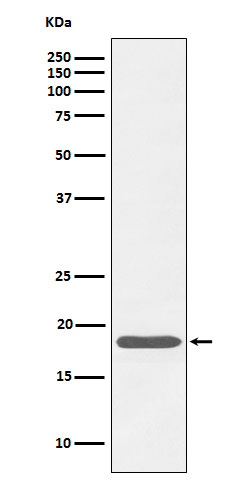

| WB | 咨询技术 | Human,Mouse,Rat |
| IF | 1/20-1/50 | Human,Mouse,Rat |
| IHC | 1/100-1/200 | Human,Mouse,Rat |
| ICC | 技术咨询 | Human,Mouse,Rat |
| FCM | 咨询技术 | Human,Mouse,Rat |
| Elisa | 咨询技术 | Human,Mouse,Rat |
| Aliases | CAV3; Caveolin 3; LGMD1C; LQT9; M-caveolin; VIP21;;Caveolin 3 |
| WB Predicted band size | 17 kDa |
| Host/Isotype | Rabbit IgG |
| Antibody Type | Primary antibody |
| Storage | Store at 4°C short term. Aliquot and store at -20°C long term. Avoid freeze/thaw cycles. |
| Species Reactivity | Human |
| Immunogen | A synthesized peptide derived from human Caveolin 3 |
| Formulation | Purified antibody in PBS with 0.05% sodium azide,0.05% BSA and 50% glycerol. |
+ +
以下是关于Caveolin-3抗体的3篇参考文献的简要概括:
1. **文献名称**:*"Caveolin-3 mutations and the pathogenesis of muscular dystrophy"*
**作者**:Parton RG, Campbell KP
**摘要**:探讨Caveolin-3基因突变如何通过破坏细胞膜小窝(caveolae)结构,导致肢带型肌营养不良症(LGMD-1C),并利用特异性抗体验证突变蛋白的异常表达与肌肉细胞功能缺陷的关联。
2. **文献名称**:*"Antibody-based analysis of Caveolin-3 in cardiomyopathies"*
**作者**:Woodman SE, Sotgia F, Lisanti MP
**摘要**:通过Caveolin-3特异性抗体检测扩张型心肌病患者心肌组织中Caveolin-3表达水平下降,提示其与心肌细胞膜稳定性丧失及心功能异常的潜在机制。
3. **文献名称**:*"Caveolin-3 antibody as a biomarker for caveolae-related diseases"*
**作者**:Gazzerro E, Bonetto A, Minetti C
**摘要**:研究Caveolin-3抗体在诊断遗传性和获得性肌肉疾病中的应用,发现其可特异性识别患者肌肉活检样本中Caveolin-3的异常定位,支持其作为临床病理诊断工具的价值。
以上文献均聚焦于Caveolin-3抗体在疾病机制研究及诊断中的应用。
Caveolin-3 (CAV3) is a muscle-specific protein integral to the formation of caveolae, small invaginations in the plasma membrane that regulate cellular signaling, membrane trafficking, and mechanical sensing. It is primarily expressed in skeletal, cardiac, and smooth muscle cells. Structurally, Caveolin-3 contains a scaffolding domain that interacts with signaling molecules, including G-proteins and receptor tyrosine kinases, to modulate pathways like nitric oxide synthesis and calcium homeostasis. Dysregulation of CAV3 is linked to muscular disorders such as limb-girdle muscular dystrophy 1C, rippling muscle disease, and cardiomyopathy, as well as arrhythmias caused by mutations affecting ion channel function.
Caveolin-3 antibodies are critical tools for studying these pathologies. They are widely used in Western blotting, immunohistochemistry (IHC), and immunofluorescence (IF) to detect CAV3 expression levels, tissue distribution, and subcellular localization. In research, these antibodies help elucidate mechanisms of caveolae-mediated signaling and membrane repair in muscle physiology. Clinically, they aid in diagnosing CAV3-related myopathies by identifying abnormal protein expression or aggregation in patient biopsies. Validation of Caveolin-3 antibodies is essential, as cross-reactivity with other caveolin isoforms (CAV1. CAV2) can occur. Recent studies also explore CAV3's role in cancer metastasis and metabolic diseases, expanding its relevance beyond neuromuscular disorders.
×